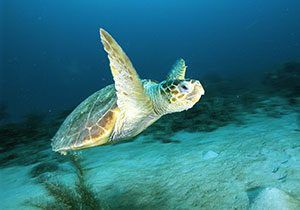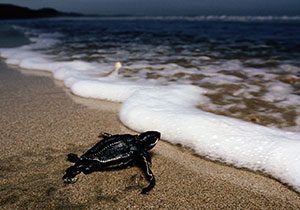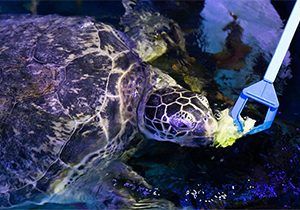14 facts about stingrays!
Discover the secrets of this fab fish…
Hey kids, get ready to hold your breath and take a dip in the sea, as we explore these intere-sting stingray facts!
With the help of our friends over at The Deep, their stingray experts have helped us put together some fishy facts on these magnificient sea creatures – and what”s more, you can download their infographic for free and stick it on your wall!
Stingrays come in all shapes and sizes and are one of the most beautiful creatures in the sea, but let’s face it, they are a little bizarre looking! Check out our cool facts about them, below…
Stingray facts
1. Rays and skates are flattened fish closely related to sharks. All belong to a group of fish called Elasmobranchs.
2. These guys are pretty unique as they have no bones in their body – their skeleton is made up of flexible cartilage (the bendy stuff that your ears and nose are made from!).
3. Although they look near identical, rays and skates are actually different. Stingrays are ovoviviparous, meaning the young are hatched from eggs that are held within the body, whereas skates are oviparous, meaning they lay eggs – these eggs are protected by a hard, rectangular case often called a “mermaid”s purse“!
4. There are many different types of ray including stingrays, electric rays, butterfly rays, round rays, manta rays, guitarfish and sawfish.
5. Stingrays use a super set of senses to search for food. Special gel-filled pits across the front of their face, (called Ampullae of Lorenzini), allow them to pick up electrical signals from other animals when they move – cool! Their eyes are on the topside of their body and their mouth and gills can be found underneath, so in the darker depths or murky rivers this electromagnetic sense is especially useful for searching for prey.
6. Many stingrays like to live by themselves and only come together for breeding and migration. Some of the largest rays such as manta rays and cow nose rays never stop swimming and migrate in their thousands to feeding grounds each year. These large groups can reach up to 10,000 individuals and are known as a “fever“.
7. Rays protect themselves with venomous spines or barbs in their tail. Skates rely on thorny projections on their backs and tails.
8. Stingrays and skates feed on crustaceans, small fish, snails, clams, shrimp and other small creatures.
9. In 2008, a female bluespotted ribbontail ray gave birth to a set of twins at The Deep aquarium in Hull – a European first!
10. Stingrays” natural predators are sharks, seals, sea lions and other large fish.

11. Electric rays are named for their ability to generate and discharge a strong electric current to stun prey and for defence from potential predators.
12. Fossil records date stingrays back to the Jurassic period, 150 million years ago!
13. Rays can vastly vary in size. The smallest ray is the short-nose electric ray which is approximately 10cm across and weighs about 400g. The oceanic manta ray is the largest ray reaching up to 7m in wing span and weighs 2,000kg.
14. Sadly, numbers of sting ray are in decline. Overfishing, habitat loss and climate change are the major threats to rays. They”re also hunted for their gill rakers (used for feeding) for use in Chinese medicine. At present, 539 species of ray assessed are under the IUCN Red List, and 107 are classified as threatened.

The Deep is part of the European Breeding Programme for the bluespotted ribbontail ray and blue spot stingray, as well as the species monitoring programme for the honeycomb whiptail ray. This means they are helping to safeguard populations of these species and are leading the way in pioneering new husbandry techniques.
More Like Sea Life

Loggerhead turtle facts!

Leatherback turtle facts!

Ernie the overweight turtle goes to bootcamp!













LEAVE A COMMENT
THANK YOU
Your comment will be checked and approved shortly.
WELL DONE,
YOUR COMMENT
HAS BEEN ADDED!
COMMENTS
this is so cool. I leaned so much cool facts about stingrays.
Cool website
nice!!!
Cool
this is a great website
Cool
wow
Cool s.facts
LMAO
This was really helpful on a slideshow that I am doing on stingrays! Thank you :)
Cool
i think it is grat
it is amazing
not what i searched
Cool
That’s awesome!!!!!!!!!!!!
I wish I had one ray as my pet in a big aquarium as I can't wait to learn more.
I love learning these fun facts all about animals from the truly fabby doo national kids. I will go Home and chat to all my family and friends about these lovely creatures.
Roooooooaaar!!!!!!!!!
cool!
love it
alsome
alsome
cooooooooooooooooooooooooooooooooooooooooooooooooooooooooooollllllllllllllllllllllllllllllllllllllllllllllllllllllllllllllllllllllllllllllllllllllllllllllllllllllllllllllllllllllllllllollllllLLLLLL
great info!
cool
fun
THE BEST
WOW!
Awsome
Boss
Sting rays are orsom.Ive always wanted one ass a pet.I never new how long they have been around!!!
Cool! These facts are really good but it only has normal facts and barely any exiting ones
Rubbish!!!
CUSTOMIZE YOUR AVATAR